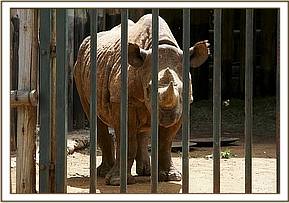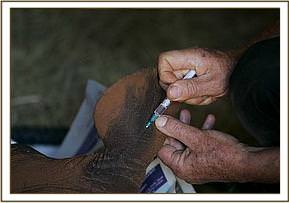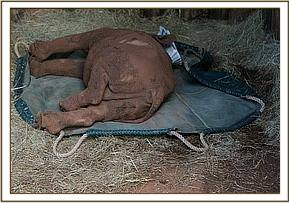21st March 2007 saw the cataract operation on the left eye of our blind baby rhino, “Maxwell or Max”, found abandoned in the Nairobi National Park forest a month ago in February
21st March 2007 saw the cataract operation on the left eye of our blind baby rhino, “Maxwell or Max”, found abandoned in the Nairobi National Park forest a month ago in February. Since he is about one year old, it is very doubtful that he was actually born blind for had that been the case, it is unlikely that he would have been in such good condition. Having verified that he was suffering from “bilateral cataracts” in both eyes, we all stood by with bated breath, as our Vet, Dr. Deiter Rottcher, handled the anaesthesia and Kenya’s top Eye Specialist, Dr. Peter Schwendemann prepared his instruments.




It was very fortunate that Dr. Schwendemann studied and practiced cataract surgery in the seventies, so he is proficient at “the old-fashioned way” as well as with the modern more sophisticated laser techniques that would have proved impossible under field conditions. Added to this, a rhino apparently does not only have the swivel movement of the eye, but also a suction mechanism enabling the eyeball to be drawn in or up and down as a protective measure. Therefore, the use of a microscope would have proved difficult, since the constant eyeball movement would put it out of focus much of the time. Using magnified goggles the Specialist was able to compensate simply by moving his head.
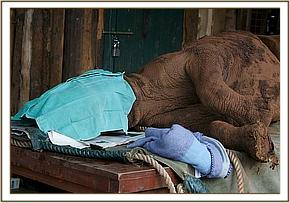
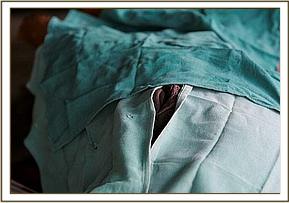

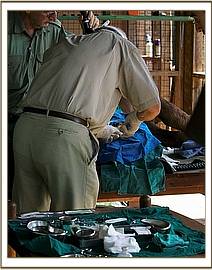

Once Max was out for the count, he was carried onto a table in the Garage, where all the instruments were prepared and waiting. Meanwhile, our older rhino, Shida, arrived unexpectedly, so he had to be incarcerated in his Stockade to ensure he did not interrupt the proceedings! Watched by many of the elephant and rhino Keepers, and wearing a headlamp on his forehead, the concentration of Dr. Schwendemann during the operation, which lasted about half an hour, was all consuming, so not a word was spoken until it was all over. Meanwhile, Dr. Rottcher kept the little rhino just under, being extremely experienced in this field, a decision having been made to operate on just one eye at a time to minimize the affects of anaesthesia.
It had always been a puzzle as to how Max came to be blind in both eyes. It is not unusual for Black Rhino to be blinded in one, the eye being damaged either during sparring bouts or when fleeing through dense thorn bush thickets where rhinos sequester themselves for protection. But why both eyes? Dr. Schwendemann was able to determine that there was evidence of a foreign body having punctured the cornea of the eye on which he was working, which probably caused the cataract to grow. It will be very interesting to see what he finds in the other eye when the time comes, assuming that the operation on the first eye proves successful and the cataract does not grow back. 



Rhinos have specific parasites that have come down the ages along with these extremely ancient animals which have been unchanged for millions of years. The Gyrostigma fly being one, and Rhinomusca flies another. It is not unlikely that there could be a scientific surprise involving an “Eye Fly” as well, for several totally blind rhinos are known in Kenya. More will be revealed when the other eye receives closer attention as well.
The prognosis is that Max will have some vision restored, but because he will be minus his eye lenses, which have had to be removed, he will not have the ability to focus, so his vision be blurred and out of focus. However, in a rhino bull, some vision is better than none, for he needs to be able to size up an opponent when it comes down to fighting for rank and territory. Rhinos have myopic vision at the best of times, moving entirely by memory, hearing and scent, senses that are finely tuned and phenomenally acute. Eyes are only needed when fighting, or confronted by danger at very close quarters.
We pray for a positive result.
Meanwhile, Cortisone eye drops have to be inserted into Max’s restored eye five times a day, something that takes place as he is enjoying his milk. So far it has been covered by an airline sleeping mask, to keep the eye clean and free of dust whilst healing takes place. The elasticized bands on either side of the mask are looped over an ear and his 2 inch horn, making him look like a pirate, and so far he hasn’t objected to wearing it!
We are most deeply indebted to the expertise of Dr. Schwendemann who has given his services free of charge, and to the German based Alcon Pharmaceuticals, who have most generously and kindly donated the cortisone ointment Max will need for some time, as well as antibiotic eye ointment for general eye infections in our growing animal family. We are grateful, too, for the proficiency of Dr. Dieter Rottcher, our Veterinarian. 